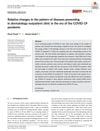Pattern Changes of Cutaneous Dermatoses Among Iraqi Women Preceding and During the COVID-19 Pandemic
November 2021
in “
F1000Research
”

TLDR The COVID-19 pandemic led to more hair loss and skin irritation among Iraqi women, with some skin conditions increasing and others decreasing.
The study "Pattern changes of cutaneous dermatoses among Iraqi women preceding and during the COVID-19 pandemic" involved 2657 participants and found that the pandemic led to changes in skin and hair conditions. Specifically, hair loss, particularly telogen effluvium, significantly increased, while certain viral skin infections decreased. Other conditions like acne vulgaris, rosacea, and vitiligo increased, while psoriasis and alopecia areata decreased, but these changes were not significant. The study suggests these changes could be due to the stress of the pandemic or the wearing of face masks. Additionally, irritant contact dermatitis increased, likely due to overuse of antiseptic agents and frequent hand and face washing. However, the study was limited as it was conducted at a single center and data was only measured over a short period.






